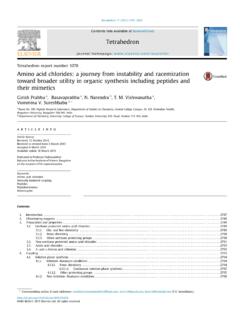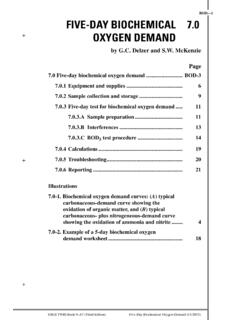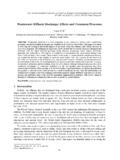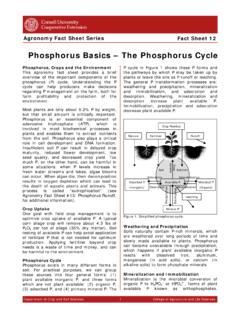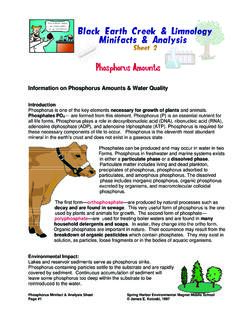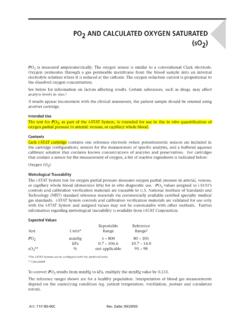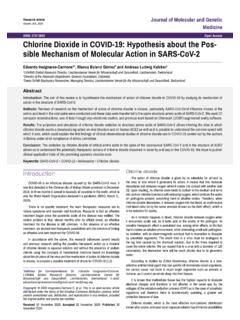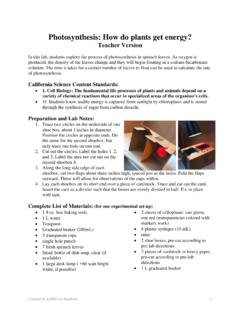Transcription of Aldehydes can react with alcohols to form hemiacetals
1 340 14 . Nucleophilic substitution at C=O with loss of carbonyl oxygen You have, in fact, already met some reactions in which the carbonyl oxygen atom can be lost, but you probably didn't notice at the time. The equilibrium between an aldehyde or ketone and its hydrate (p. 000) is one such reaction. O HO OH. H2O +. R1 R2 R1 R2. When the hydrate reverts to starting materials, either of its two oxygen atoms must leave: one OPh came from the water and one from the carbonyl group, so 50% of the time the oxygen atom that belonged to the carbonyl group will be lost. Usually, this is of no consequence, but it can be useful.
2 O For example, in 1968 some chemists studying the reactions that take place inside mass spectrometers needed to label the carbonyl oxygen atom of this ketone with the isotope 18O. By stirring the normal' 16O compound with a large excess of isotopically labelled water, H218O, for a few hours in the presence of a drop of acid they were able to make the required labelled com- L. In Chapter 13 we saw this way of pound. Without the acid catalyst, the exchange is very slow. Acid catalysis speeds the reaction up by making a reaction go faster by raising making the carbonyl group more electrophilic so that equilibrium is reached more quickly.
3 The the energy of the starting material. We also saw that the position of an equilibrium is controlled by mass action 18O is in large excess. equilibrium can be altered by using a large excess of one of the reagents. OPh OPh OPh This is often called a mass action effect. OH. O OH. 18. OH2. 18. H OH2. OPh OPh OPh OH2. 18 18. O OH 18. OH. We need now to discuss hemiacetals though you may well wonder why they retain the carbonyl oxygen and they are unstable. We need to discuss them as a preliminary to the much more important acetals. hemiacetals are halfway to acetals. Aldehydes can react with alcohols to form hemiacetals When acetaldehyde is dissolved in methanol, a reaction takes place: we know this because the IR.
4 Spectrum of the mixture shows that a new compound has been formed. However, isolating the prod- uct is impossible: it decomposes back to acetaldehyde and methanol. IR: O MeOH no peak in carbonyl O. region 1600 1800 attempt to purify + MeOH. Me H strong OH stretch Me H. 3000 3500. The product is in fact a hemiacetal. Like hydrates, most hemiacetals are unstable with respect to their parent Aldehydes and alcohols : for example, the equilibrium constant for reaction of acetalde- hyde with simple alcohols is about as we saw in Chapter 13. MeO OH O K = ~ MeO OH. + MeOH. Me H Me H Me H. hemiacetal aldehyde hemiacetal Aldehydes can react with alcohols to form hemiacetals 341.
5 This equilibrium constant K is defined as [hemiacetal]. K =. [aldehyde][MeOH]. So by making [MeOH] very large (using it as the solvent, for example) we can turn most of the L. aldehyde into the hemiacetal. However, if we try and purify the hemiacetal by removing the These are more mass action' effects methanol, more hemiacetal keeps decomposing to maintain the equilibrium constant. That is why like the 18O exchange we have just discussed. we can never isolate such hemiacetals in a pure form. Only a few hemiacetals are stable Like their hydrates, the hemiacetals of most ketones (sometimes called hemiketals) are even less sta- L.
6 Ble than those of Aldehydes . On the other hand, some hemiacetals of Aldehydes bearing electron- We discussed the reasons for this in withdrawing groups, and those of cyclopropanones, are stable, just like the hydrates of the same Chapter 6. molecules. H OEt EtOH. Br3C O Br3C OH. a stable hemiacetal hemiacetals that can be formed by intramolecular cyclization of an alcohol on to an aldehyde are also often stable, especially if a five- or six-membered ring is formed. You met this in Chapter 6 . many sugars (for example, glucose) are cyclic hemiacetals , and exist in solution as a mixture of open- chain and cyclic forms.
7 Glucose: open-chain form cyclic form OH OH O OH. HO. HO CHO. HO OH. OH OH. OH. > 99%. Why are cyclic hemiacetals stable? Part of the reason for the stability of cyclic measure the stability of a cyclic hemiacetal by the rate of the forward reaction divided by the rate of the hemiacetals concerns entropy. Formation of an equilibrium constant K for the ring-opening reaction: reverse reaction. So, for a stable hemiacetal, we acyclic acetal involves a decrease in entropy ( S a large K means lots of ring-opened product, and need a fast hemiacetal-forming reaction. And when negative) because two molecules are consumed for therefore an unstable hemiacetal, and a small K the hemiacetal is cyclic that is just what we do have: every one produced.
8 This is not the case for means lots of ring-closed product: a stable the reaction is intramolecular and the nucleophilic formation of a cyclic hemiacetal. Since G = H hemiacetal. After reading Chapter 13 you should OH group is always held close to the carbonyl group, T S , a reaction with a negative S tends to have a appreciate that an equilibrium constant is simply the ready to attack. more positive G ; in other words, it is less favourable. equilibrium constant kforward HO. HO O O. Another way to view the situation is to consider the kforward rates of the forward and reverse processes. We can K=.
9 Kreverse kreverse fast for cyclic hemiacetals Acid or base catalysts increase the rate of equilibration of hemiacetals with their aldehyde and alcohol parents Acyclic hemiacetals form relatively slowly from an aldehyde or ketone plus an alcohol, but their rate of formation is greatly increased either by acid or by base. As you would expect, after Chapters 12. and 13, acid catalysts work by increasing the electrophilicity of the carbonyl group. 342 14 . Nucleophilic substitution at C=O with loss of carbonyl oxygen acid-catalysed hemiacetal formation H H. Me O OH HO O HO OMe Me H Me H Me H Me H.
10 Hemiacetal OH. Me Base catalysts, on the other hand, work by increasing the nucleophilicity of the alcohol by remov- ing the OH proton before it attacks the C=O group. In both cases the energy of the starting materials is raised: in the acid-catalysed reaction the aldehyde is destabilized by protonation and in the base- catalysed reaction the alcohol is destabilized by deprotonation. base-catalysed hemiacetal formation H base base makes alcohol Me Me O O O O. Me H more nucleophilic HO O. O. Me Me H Me H Me H. base hemiacetal You can see why hemiacetals are unstable: they are essentially tetrahedral intermediates contain- ing a leaving group and, just as acid or base catalyses the formation of hemiacetals , acid or base also catalyses their decomposition back to starting aldehyde or ketone and alcohol.

